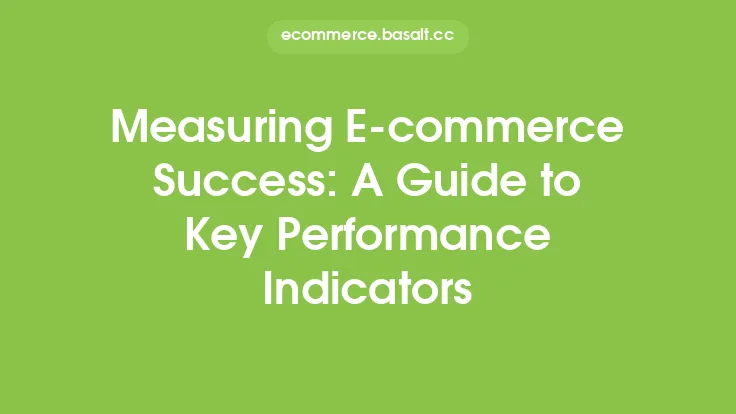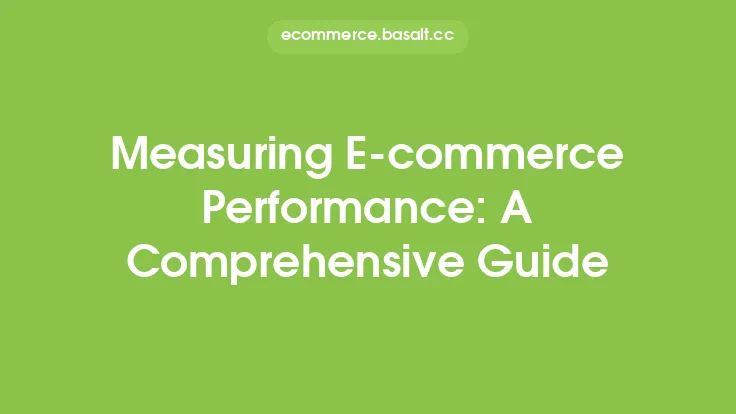Measuring the success of an e-commerce business is crucial for its growth and sustainability. With the ever-increasing competition in the online market, it's essential to track and analyze performance metrics to make informed decisions. In this article, we'll delve into the world of e-commerce analytics and explore the key performance metrics that can help you measure the success of your online store.
Introduction to E-commerce Performance Metrics
E-commerce performance metrics are quantifiable measures that help you evaluate the performance of your online store. These metrics provide insights into various aspects of your business, such as sales, customer behavior, marketing effectiveness, and operational efficiency. By tracking and analyzing these metrics, you can identify areas of strength and weakness, set realistic goals, and make data-driven decisions to improve your business.
Types of E-commerce Performance Metrics
There are several types of e-commerce performance metrics, each providing unique insights into your business. Some of the most common metrics include:
- Sales metrics: These metrics measure the revenue generated by your online store, including total sales, average order value, and conversion rate.
- Customer metrics: These metrics provide insights into customer behavior, such as customer acquisition cost, customer retention rate, and customer lifetime value.
- Marketing metrics: These metrics evaluate the effectiveness of your marketing campaigns, including return on ad spend, click-through rate, and social media engagement.
- Operational metrics: These metrics measure the efficiency of your online store's operations, including order fulfillment rate, shipping time, and inventory turnover.
Key Performance Indicators (KPIs) for E-commerce
Key Performance Indicators (KPIs) are specific metrics that help you measure the success of your e-commerce business. Some of the most important KPIs for e-commerce include:
- Conversion rate: The percentage of website visitors who complete a purchase.
- Average order value (AOV): The average amount spent by customers in a single transaction.
- Customer retention rate: The percentage of customers who return to make repeat purchases.
- Cart abandonment rate: The percentage of customers who abandon their shopping carts without completing a purchase.
- Return on investment (ROI): The revenue generated by a marketing campaign or investment, compared to its cost.
How to Track and Analyze E-commerce Performance Metrics
Tracking and analyzing e-commerce performance metrics requires the use of specialized tools and software. Some of the most popular e-commerce analytics tools include Google Analytics, Adobe Analytics, and Shopify Analytics. These tools provide detailed reports and dashboards that help you track and analyze your performance metrics. You can also use spreadsheets and data visualization tools to create custom reports and dashboards.
Best Practices for Measuring E-commerce Success
To get the most out of your e-commerce performance metrics, follow these best practices:
- Set clear goals and objectives: Establish specific, measurable, achievable, relevant, and time-bound (SMART) goals for your e-commerce business.
- Track and analyze metrics regularly: Regularly review and analyze your performance metrics to identify trends, patterns, and areas for improvement.
- Use data to inform decisions: Use your performance metrics to make informed decisions about marketing, operations, and customer experience.
- Monitor and adjust: Continuously monitor your performance metrics and adjust your strategies as needed to optimize results.
Common Challenges in Measuring E-commerce Success
Measuring e-commerce success can be challenging, especially for small and medium-sized businesses. Some common challenges include:
- Data quality and accuracy: Ensuring that your data is accurate, complete, and consistent can be a challenge.
- Data overload: With so many metrics to track, it can be overwhelming to know where to focus.
- Limited resources: Small and medium-sized businesses may not have the resources or expertise to effectively track and analyze performance metrics.
- Changing market conditions: E-commerce is a rapidly evolving market, and changing market conditions can make it difficult to measure success.
Conclusion
Measuring e-commerce success is crucial for the growth and sustainability of your online business. By tracking and analyzing key performance metrics, you can gain valuable insights into your business and make informed decisions to drive growth and improvement. Remember to set clear goals, track and analyze metrics regularly, and use data to inform decisions. With the right tools and strategies, you can overcome common challenges and achieve success in the competitive world of e-commerce.





